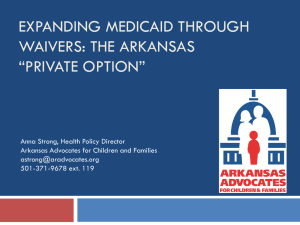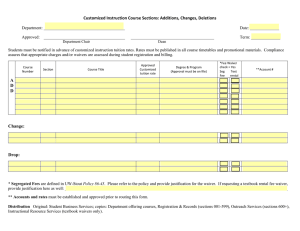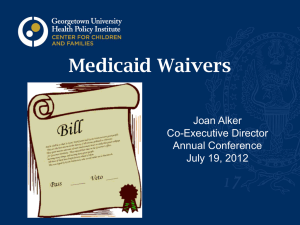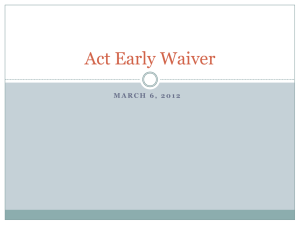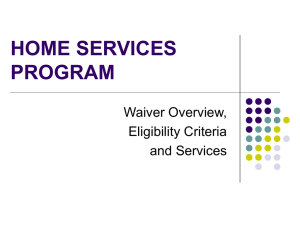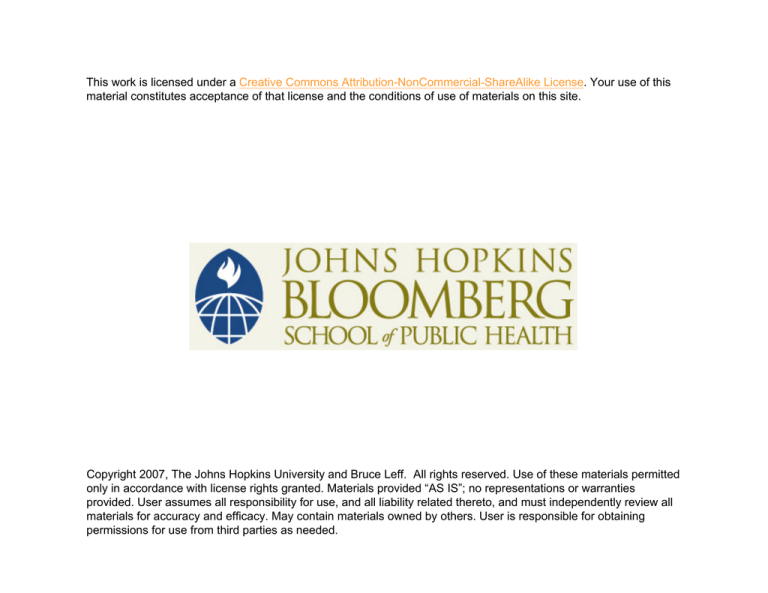
This work is licensed under a Creative Commons Attribution-NonCommercial-ShareAlike License. Your use of this
material constitutes acceptance of that license and the conditions of use of materials on this site.
Copyright 2007, The Johns Hopkins University and Bruce Leff. All rights reserved. Use of these materials permitted
only in accordance with license rights granted. Materials provided “AS IS”; no representations or warranties
provided. User assumes all responsibility for use, and all liability related thereto, and must independently review all
materials for accuracy and efficacy. May contain materials owned by others. User is responsible for obtaining
permissions for use from third parties as needed.
What’s New in Maryland
Medicaid
Alice Burton and Jill Spector
Department of Health and Mental Hygiene
October 2007
2
Overview
I Big
Picture
I Health Care Reform
I Long Term Care
•
•
•
•
Current System
HCBS Waivers
CommunityChoice
DRA
3
Big Picture
I
I
I
I
I
FY2008 Medicaid budget is $5.1 billion
Medicaid growth is not sustainable
Over the past several years, the average annual
growth rate for Medicaid expenditures has been close
to 9% per year (although trends have slowed in the
most recent fiscal year)
• Pharmacy costs up approximately 12% per year
• Long term care costs up approximately 10% over
the past several years
Medicaid makes up an increasingly large portion of
the State budget – approximately 16% (general
funds)
Long term care services: 30% of the Medicaid budget
for 5% of population
4
Public Coverage
(Effective 07/01/06)
Pregnant Women
300
300
MCHP
Premium
250
200
185
MCHP
133
Medicare
100
Primary Adult Care
Program – 116% FPL
40
Medicaid
PW
0
1
6
Poverty Level:
1 person = $10,210
2 persons =$13,690
4 persons = $20,650
As of 1/24/2007
Parents or disabled
age 19 to 64
19
Age 65 and
Over+
Note: This chart is for illustrative purposes only. Each coverage group has specific
eligibility and some asset requirements, which are not shown.
5
Medicaid Expenses by Enrollment
Category
100%
90%
80%
70%
5.4%
18.4%
18.0%
9.3%
60%
50%
40%
30%
20%
48.6%
63.7%
Elderly
Disabled
Adult
Child
10.6%
22.5%
10%
0%
Enrollees = 594,300
6
Payments = $5.06 Billion
Excludes data for individuals with partial benefits
Medicaid Long Term Care Today
I Fee
for service
I Defined benefits package
I Institutional bias
I Case management is service-specific
I 1915(c) waivers offer better benefits to
a limited population
7
Current Long Term Care System
I Fundamental
problems in Medicaid
• No systemic incentives for cost efficiency,
especially if savings accrue to Medicare
• No coordination with Medicare
• Not sufficient flexibility to provide services
that best meet the needs of consumers
• System is fragmented, not consumerfriendly
8
People want to live in the community!
I States
are looking for new ways to keep
people in the community or transition
them from nursing homes
• Home and Community-based services
(HCBS) waiver programs/1915c waivers
• Managed LTC/CommunityChoice
• Deficit Reduction Act
9
HCBS Waivers
I
I
I
I
Waiver authority enacted by Congress in 1981
Expand HCBS access to individuals who meet
institutional level of care
Allow states to waive certain federal
requirements
• Expand covered services to include services
not traditionally covered by Medicaid
• Establish specific financial and technical
eligibility criteria for the waiver
Cost-effectiveness requirement
• Cannot cost more to serve waiver enrollees in
community than in an institution
10
HCBS Waivers
Maryland has 7 HCBS waivers; In FY08,
waivers will serve more than 16,600
individuals.
I There is a high demand for waiver services.
I Many waivers are out of “slots” and not
accepting new community applicants.
I In December 2002, DHMH developed a
“Money Follows the Person” policy
• Individuals in nursing facilities whose
services are paid by Medicaid may apply to
the OAW or LAH waiver, regardless of the
number of available “slots”
I
11
HCBS Waivers
Funded Waiver
Slots - FY08
Waiver
3,750
Older Adults Waiver
Living at Home Waiver
500
Waiver for Children with Autism Spectrum Disorder
900
Waiver for Individuals with Developmental Disabilities
10,988
New Directions Waiver (Developmental Disabilities)
300
Model Waiver for Medically Fragile Children
200
Waiver for Individuals with Traumatic Brain Injury
35
12
12
Waiver Services Registry
I As
of September 2007, the Waiver
Services Registry has:
• 9,800 individuals interested in OAW
• 1,780 individuals interested in LAH
• 2,125 individuals interested in AUT
13
CommunityChoice Goals
Develop alternatives to institutional care
I Coordinate acute and long term care services
and financing with Medicare
I Control growth of long term care costs
I Flexibility to provide services specific to the
needs of the client (e.g. assisted living, home
modifications)
I Accountability for outcomes and quality of
care
I Develop consumer-directed options
I
14
Proposal
I
Managed care program called
CommunityChoice
• Legislation passed in 2003, vetoed by legislature,
overridden by Governor
Mandatory enrollment for dual eligibles and
people who need LTC
I Enrollees required to choose a “community
care organization” or “CCO” that becomes
responsible for all Medicaid services
I Integrate financing and management with
Medicare to the extent possible
I Build on concept of PACE program
I
15
Population
All adult dual eligibles (approx. 75,000
statewide)
I All adult Medicaid recipients who qualify for
nursing home level of care
I All other Medicaid recipients age 65+
I Includes:
I
• All nursing facility residents
• Participants from two 1915(c) waivers
– Older Adults Waiver
– Living at Home Waiver
16
Proposal
Services include primary, acute, and long
term care services, and flexibility to cover
other services to meet enrollees’ needs
I Expanded HCBS services to more people
I
I
Entirely new perspective on quality assurance
• Aggressive quality assurance and quality
improvement
• Focus on outcomes
17
Legislative Mandates
I Specialty
mental health services are
carved out of CommunityChoice
I Revised to pilot in two geographic areas
of the State (two-thirds of statewide
population)
• In those areas, enrollment will be
mandatory
I Certain
provider rate guarantees
18
Challenges & Opportunities
I Coordination
with Medicare and
integrating the financing of care
I Protecting consumers’ rights, choice,
access to high-quality health care
I Politics and special interests
I Developing capitation rates for
population
19
Now What?
I Sent
to CMS in August 2005, CMS
denied in March 2007
• Redo as a 1915 (b) and (c)
I Lessons
Learned
I Next Steps: new LTC plan in January
2008
20
Deficit Reduction Act (DRA)
Federal government passed DRA in February
2006.
I Expected to save millions of dollars through
“reductions” by beneficiary premiums/cost
sharing, changes in benefits and stricter
asset transfer rules
I Mandatory and optional initiatives
I Maryland awarded Money Follows the Person
rebalancing demonstration grant
I
21
Money Follows the Person Rebalancing
Demonstration
I
I
I
Creates a new program to offer enhanced services
to individuals who transition from an institution to the
community
Enhanced match for participants for one year (75%
FFP, 25% GF)
Eligibility for MFP
• Six months in an institution, at least one month of Medicaid
eligibility
• Participants must transition from a qualified institution to a
qualified community residence
• Maximum of four unrelated individuals in a single residence
22
Money Follows the Person Rebalancing
Demonstration
I Inclusive
stakeholder process, multiple
planning meetings
I Operational protocol due t CMS by
November 1, 2007
I Program to begin in 2008
23


